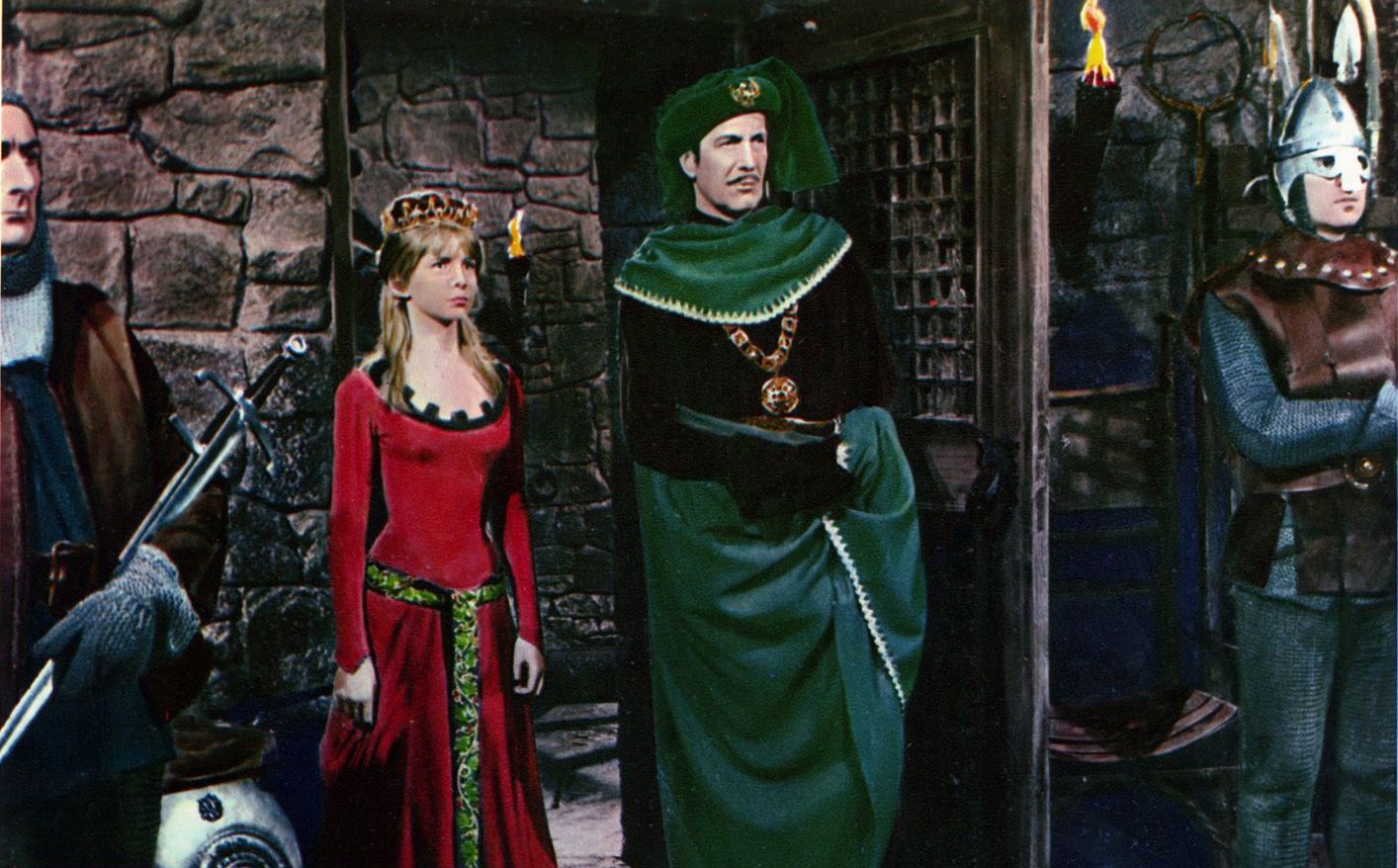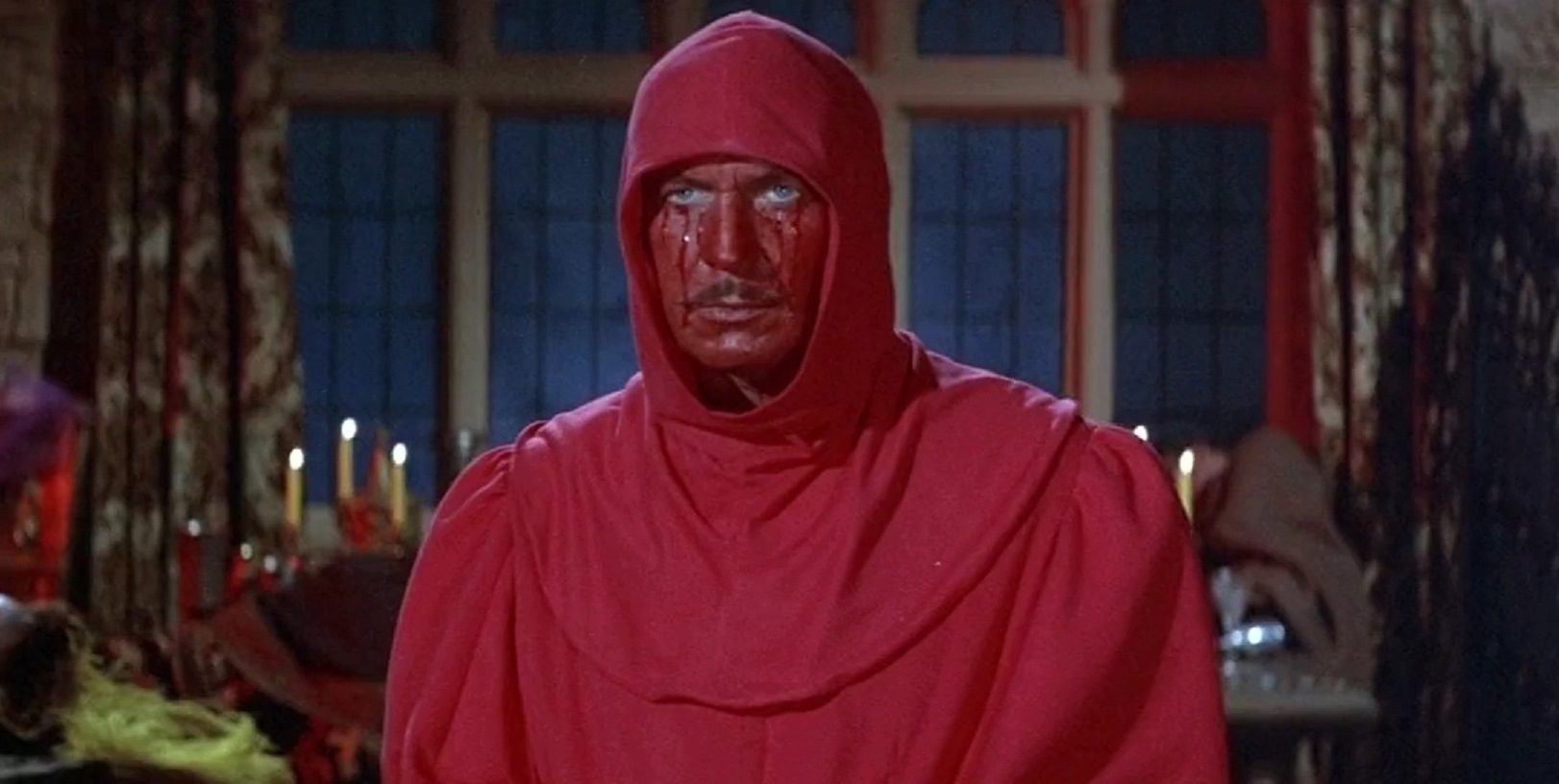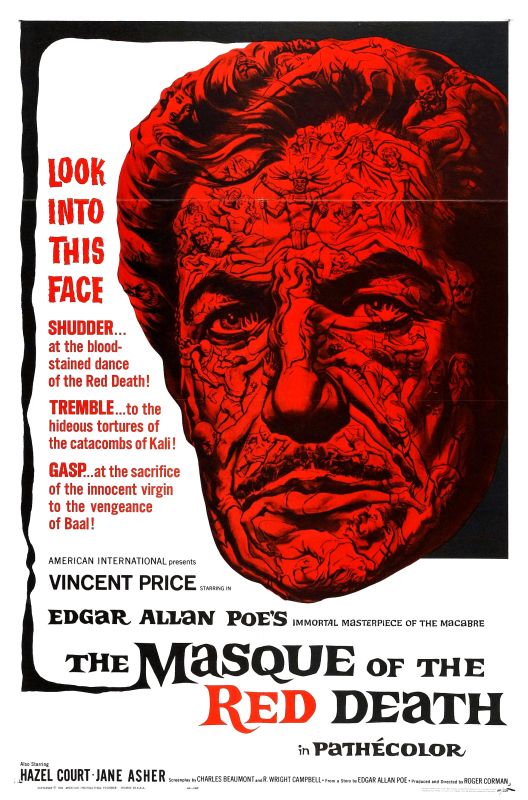USA. 1964.
Crew
Director/Producer – Roger Corman, Screenplay – Charles Beaumont & R. Wright Campell, Based on the Short Story The Masque of the Red Death (1864) by Edgar Allan Poe, Photography – Nicolas Roeg, Music – David Lee, Special Effects – George Blackwell, Makeup – George Partleton, Production Design – Daniel Haller. Production Company – AIP.
Cast
Vincent Price (Prince Prospero), Jane Asher (Francesca), Hazel Court (Juliana), Patrick Magee (Alfredo), David Weston (Gino), Skip Martin (Hop Toad), Nigel Green (Ludovico)
Plot
The cruel and sadistic Prince Prospero burns the village of Cartania to the ground when he finds that one villager has contracted the Red Death. The innocent Francesca begs Prospero to save the lives of her father and the man she loves, so Prospero asks her to choose which one he will kill and which he shall spare. Prospero then decides to take all of them to his castle. There he, a practicing Satanist, is determined to corrupt Francesca’s innocence. However, the Red Death has promised the villagers their freedom and makes a surprise appearance during a costumed masque held by Prospero.
The Masque of the Red Death was one of the seven-and-a-half Edgar Allan Poe adaptations made by producer-director Roger Corman between 1960 and 1964. (The half is The Haunted Palace (1963), which only uses the title of Poe’s poem and in fact adapts an H.P. Lovecraft story). In his Edgar Allan Poe series, Roger Corman was clearly inspired by the Gothic revival that had been stimulated by Hammer Films in England beginning in 1957.
The Edgar Allan Poe adaptations, all but one of which starred Vincent Price, brought Roger Corman critical attention as a director and took him away from being a director of the no-budget (albeit zesty) hackwork he had churned out for James H. Nicholson and Samuel Z. Arkoff at American International Pictures in the late 1950s. The Masque of the Red Death was the sixth and second to last of Roger Corman’s Poe adaptations and is generally the most critically acclaimed of them all.
As with most of Roger Corman’s Edgar Allan Poe adaptations, Corman and his writers – in this case acclaimed fantasy author Charles Beaumont, who wrote 7 Faces of Dr Lao (1964) and science-fiction author R. Wright Campbell – have taken a fragment that is the Edgar Allan Poe story and padded it out into a feature-length script. The Masque of the Red Death (1842) is a three-page short story, which is essentially a set-up for a sombre twist ending where the Red Death attends Prospero’s masque in person. Thus Charles Beaumont and R. Wright Campbell have to invent a backstory to make Prospero come to life. (They also throw in the Edgar Allan Poe story Hop-Frog (1849) to pad things out).

They make the script into an amazing study in cruelty and sadism. In the opening scene, Jane Asher begs for the lives of her father (Nigel Green) and lover (David Weston) to be told by Vincent Price that she must choose which of the two will be allowed to live; later Price constructs a game where the two men must alternately gash themselves with daggers, not knowing which of the daggers is poisoned. A husband and wife come begging Prospero’s asylum from the Red Death, the man offering his wife to Vincent Price to which Price coldly replies “I’ve already had that pleasure” and then shoots the man with a crossbow bolt and throws the woman a sword “Spare yourself madam.”
In this version, Prospero and Prospero’s sister, played by an alarmingly jealous Hazel Court, are also Satanists. This makes The Masque of the Red Death the first Hollywood film, apart from fitful early attempts such as The Black Cat (1934) and The Seventh Victim (1943), to actually mention Satanism. It is fairly tame in comparison to the depictions of Satanism that emerged after Rosemary’s Baby (1968) and The Exorcist (1973) – not much more than a drug-trip sequence with a few cackling masked figures, although there is a good shock sequence where Hazel Court brands herself as Satan’s bride with an inverted crucifix.
The Masque of the Red Death is the most sumptuous of all Roger Corman’s Edgar Allan Poe adaptations with some expansive castle interior sets, most notably a series of interlocked rooms with each in a single colour scheme. (This was the point that Roger Corman moved production base of the Poe films to the UK and was able to take much greater advantage of the studios there and make his budget go further). The film is also luxuriously photographed by a young Nicolas Roeg, who would only a few years later embark on his own directorial career with the likes of Don’t Look Now (1973), The Man Who Fell to Earth (1976) and The Witches (1990).

Roger Corman later produced a cheap and disappointing remake Masque of Red Death (1989) with Adrian Paul as Prospero. Other films adaptations of Edgar Allan Poe’s The Masque of Red Death (1842) include:- the silent Plague of Florence (1919) with a script from Fritz Lang; the modernised The Masque of the Red Death (1989) where the Red Death is a slasher maniac; and an episode of the animated anthology Extraordinary Tales (2015).
Roger Corman’s other Edgar Allan Poe films are The House of Usher/The Fall of the House of Usher (1960), Pit and the Pendulum (1961), Premature Burial (1962), Tales of Terror (1962), The Raven (1963), the Poe-titled but H.P. Lovecraft adapted The Haunted Palace (1963) and The Tomb of Ligeia (1964).
Roger Corman’s other genre films as director are:– Day the World Ended (1955), It Conquered the World (1956), Attack of the Crab Monsters (1957), Not Of This Earth (1957), The Saga of the Viking Women and Their Journey to the Waters of the Great Sea Serpent (1957), The Undead (1957), Teenage Caveman (1958), War of the Satellites (1958), A Bucket of Blood (1959), The Wasp Woman (1959), Last Woman on Earth (1960), The Little Shop of Horrors (1960), Creature from the Haunted Sea (1961), Tower of London (1962), The Terror (1963), X – The Man with X-Ray Eyes (1963), The Trip (1967), Gas; or It Became Necessary to Destroy the World in Order to Save It (1970) and Frankenstein Unbound (1990). Corman’s World: Exploits of a Hollywood Rebel (2011) is a documentary about Corman’s career.
Charles Beaumont (1929-67) was a noted horror and science-fiction writer during the 1950s and 60s. He wrote a number of screenplays including Queen of Outer Space (1958), Night of the Eagle/Burn, Witch, Burn (1961), Premature Burial (1962) and The Haunted Palace (1963) for Roger Corman, The Wonderful World of the Brothers Grimm (1962), 7 Faces of Dr Lao (1964) and the posthumously produced Brain Dead (1990), as well as twenty-two scripts for tv’s The Twilight Zone (1959-63),
Trailer here


